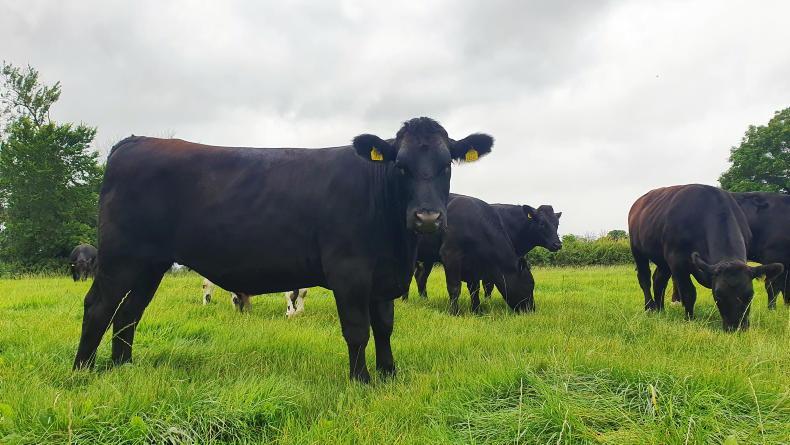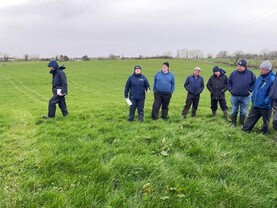The finishing phase has started on the Thrive demonstration farm in Cashel, Co Tipperary, where the 2020-born stock are now being fed meal at grass prior to slaughter.
The farm operates a 19-month production system with a target of slaughtering as many of the 140 bullocks and heifers off grass each year as possible.
All stock were weighed three weeks ago on 29 July, when animals were just over 17 months old. The heifers weighed 467kg while the bullocks were an average weight of 528kg.
Looking at performance since turnout, that translates to a daily liveweight gain of just over 1.1kg/day for the bullocks and 0.86kg/day for the heifers.
The bullocks’ performance is just above the previous two years.

This AA2163-sired bullock weighed 580kg on 29 July.
However, the heifers’ performance is ever so slightly back on last year, meaning they were about 7kg lighter on average than expected.
In saying this, 2021 heifers are carrying significantly more flesh than at the same point last year.
This should mean less meal feeding required pre-slaughter and possibly an earlier average slaughter date.
Figure 1 shows the Thrive 19-month production system blueprint for both bullocks (in blue) and heifers (in red).
As can be seen from the broken green line that represents this year’s finishing bullocks, they are about 15kg liveweight ahead of the blueprint target weight at the start of the finishing phase.
This 15kg was built up over the last three production phases – about 5kg during last autumn grazing, 5kg over the winter period and a further 5kg since turnout to grass. This shows how important it is to get each and every step of the system correct.
The aim now is to see if we can carry this extra weight through to slaughter in terms of extra kilos of carcase or an earlier slaughter date.
Finishing strategy
From the last weighing, any heifer over 470kg and any bullock over 500kg was drafted out to start getting meal at grass.
There are two main reasons why we selected these weights for drafting. First of all, for the heifers, we are targeting an average carcase weight of 275kg at 19 months old. Therefore, we do not want to slaughter heifers any lighter than 500kg, if possible.
A 500kg heifer will result in around a 255kg carcase, which is as light as we would like to see. It is expected to have a spread of carcase weights from the heifers ranging from 255kg up to 315kg.
If heifers were to start getting a significant amount of meal at lighter weights, they are more likely to go over-fat too soon.
This results in either a light carcase weight or else taking a price hit on carcase fat score in the factory.
The second reason is related to performance. These types of animals tend not to perform for long periods on concentrates.
Therefore, the target is to feed bullocks for a maximum of 10 weeks and heifers for a maximum of eight weeks pre-slaughter.
The concentrate being fed to the finishing stock at grass is a four-way mix of barley, maize, soya hulls and distillers grains. This is costing €305/t, an increase of €40/t on the same time last year.
Energy is the main requirement for a finishing ration. All we are trying to do is to top up the energy component of the diet that may be starting to reduce in the grass as we enter autumn.
There is no need for high-protein rations when finishing cattle off grass. This mix is 12% protein, which is more than adequate.
The groups getting meal at grass started at 2kg/day and then moved to 3kg/day after a few days. The heifers have remained on 3kg/day, while the bullocks have now been increased to 4kg/day at this stage.
Meal is being offered under the electric wire while ground conditions are good.
Over the next few weeks, if ground conditions start to deteriorate, cattle will either be brought in to the shed for feeding each day or a hard-stand area will be used to avoid poaching fields.
This year’s calves were also weighed recently (Table 2).
The heifers averaged 166kg and the bullocks weighed 172kg.
These 150 calves have an average birth date of 25 February and since their last weighing in late May, they have achieved a daily liveweight gain of 0.88kg/day and 0.97kg/day for heifers and bullocks, respectively.
Again, looking at the blueprint, (Figure 1) this year’s calves (black and brown lines) are on, or just above, the target weight for this time of year.
The focus now turns to maintaining performance throughout autumn, which is often a time when performance can struggle and calves fall behind target.
The calves have continued to receive meal at grass all summer this year, whereas in previous years meal feeding ceased to at least some calves for June, July and August.
In saying this, the oldest batch of calves did reduce to 0.5kg/day from mid-June until the beginning of August.
The reason for continuing meal feeding this year was that it makes herding a lot easier as calves come running to eat their meal every day.
This makes seeing any animal that is off form much easier and you will pick up any sickness at the earliest point.
Growth
Also, once the burst of growth came in June, grass quality did suffer slightly as swards headed out, even at very low covers.
Keeping the meal in the diet made sure performance did not take a hit.
All calves are now on 1kg/day of a 16% protein nut, fed in troughs in the paddock they are grazing. They will remain on this level of meal up until housing.
The bull calves were castrated two weeks ago. Pneumonia vaccination protocols will begin in the coming weeks for calves in preparation for housing.
Read more
Thrive weekly roundup: calf performance in autumn and Roscommon farm walk
Watch: meal feeding update from Thrive demo farm
The finishing phase has started on the Thrive demonstration farm in Cashel, Co Tipperary, where the 2020-born stock are now being fed meal at grass prior to slaughter.
The farm operates a 19-month production system with a target of slaughtering as many of the 140 bullocks and heifers off grass each year as possible.
All stock were weighed three weeks ago on 29 July, when animals were just over 17 months old. The heifers weighed 467kg while the bullocks were an average weight of 528kg.
Looking at performance since turnout, that translates to a daily liveweight gain of just over 1.1kg/day for the bullocks and 0.86kg/day for the heifers.
The bullocks’ performance is just above the previous two years.

This AA2163-sired bullock weighed 580kg on 29 July.
However, the heifers’ performance is ever so slightly back on last year, meaning they were about 7kg lighter on average than expected.
In saying this, 2021 heifers are carrying significantly more flesh than at the same point last year.
This should mean less meal feeding required pre-slaughter and possibly an earlier average slaughter date.
Figure 1 shows the Thrive 19-month production system blueprint for both bullocks (in blue) and heifers (in red).
As can be seen from the broken green line that represents this year’s finishing bullocks, they are about 15kg liveweight ahead of the blueprint target weight at the start of the finishing phase.
This 15kg was built up over the last three production phases – about 5kg during last autumn grazing, 5kg over the winter period and a further 5kg since turnout to grass. This shows how important it is to get each and every step of the system correct.
The aim now is to see if we can carry this extra weight through to slaughter in terms of extra kilos of carcase or an earlier slaughter date.
Finishing strategy
From the last weighing, any heifer over 470kg and any bullock over 500kg was drafted out to start getting meal at grass.
There are two main reasons why we selected these weights for drafting. First of all, for the heifers, we are targeting an average carcase weight of 275kg at 19 months old. Therefore, we do not want to slaughter heifers any lighter than 500kg, if possible.
A 500kg heifer will result in around a 255kg carcase, which is as light as we would like to see. It is expected to have a spread of carcase weights from the heifers ranging from 255kg up to 315kg.
If heifers were to start getting a significant amount of meal at lighter weights, they are more likely to go over-fat too soon.
This results in either a light carcase weight or else taking a price hit on carcase fat score in the factory.
The second reason is related to performance. These types of animals tend not to perform for long periods on concentrates.
Therefore, the target is to feed bullocks for a maximum of 10 weeks and heifers for a maximum of eight weeks pre-slaughter.
The concentrate being fed to the finishing stock at grass is a four-way mix of barley, maize, soya hulls and distillers grains. This is costing €305/t, an increase of €40/t on the same time last year.
Energy is the main requirement for a finishing ration. All we are trying to do is to top up the energy component of the diet that may be starting to reduce in the grass as we enter autumn.
There is no need for high-protein rations when finishing cattle off grass. This mix is 12% protein, which is more than adequate.
The groups getting meal at grass started at 2kg/day and then moved to 3kg/day after a few days. The heifers have remained on 3kg/day, while the bullocks have now been increased to 4kg/day at this stage.
Meal is being offered under the electric wire while ground conditions are good.
Over the next few weeks, if ground conditions start to deteriorate, cattle will either be brought in to the shed for feeding each day or a hard-stand area will be used to avoid poaching fields.
This year’s calves were also weighed recently (Table 2).
The heifers averaged 166kg and the bullocks weighed 172kg.
These 150 calves have an average birth date of 25 February and since their last weighing in late May, they have achieved a daily liveweight gain of 0.88kg/day and 0.97kg/day for heifers and bullocks, respectively.
Again, looking at the blueprint, (Figure 1) this year’s calves (black and brown lines) are on, or just above, the target weight for this time of year.
The focus now turns to maintaining performance throughout autumn, which is often a time when performance can struggle and calves fall behind target.
The calves have continued to receive meal at grass all summer this year, whereas in previous years meal feeding ceased to at least some calves for June, July and August.
In saying this, the oldest batch of calves did reduce to 0.5kg/day from mid-June until the beginning of August.
The reason for continuing meal feeding this year was that it makes herding a lot easier as calves come running to eat their meal every day.
This makes seeing any animal that is off form much easier and you will pick up any sickness at the earliest point.
Growth
Also, once the burst of growth came in June, grass quality did suffer slightly as swards headed out, even at very low covers.
Keeping the meal in the diet made sure performance did not take a hit.
All calves are now on 1kg/day of a 16% protein nut, fed in troughs in the paddock they are grazing. They will remain on this level of meal up until housing.
The bull calves were castrated two weeks ago. Pneumonia vaccination protocols will begin in the coming weeks for calves in preparation for housing.
Read more
Thrive weekly roundup: calf performance in autumn and Roscommon farm walk
Watch: meal feeding update from Thrive demo farm







 This is a subscriber-only article
This is a subscriber-only article











SHARING OPTIONS: